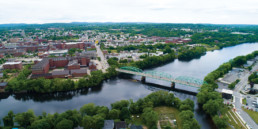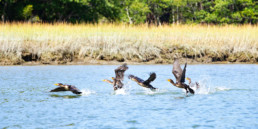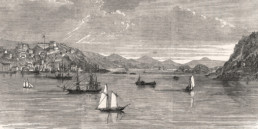DANIEL MINTER
Othered: Displaced
from Malaga
Excerpted from an exhibition and catalogue featuring paintings produced by Daniel Minter’s artist-in-residency at the University of Southern Maine, Gorham, in late 2018.
Daniel Minter uses his art as a tool for dialogue with his community. He is the co-founder and creative visionary of the Portland Freedom Trail, a system of granite and bronze markers that constitutes a permanent walking trail highlighting the people, places, and events associated with the anti-slavery movement in Portland. Minter’s work also marks the Malaga Island Trail commemorating the Black, European, and Native American residents of the island who were forcibly removed by the state of Maine in 1912.
Minter’s paintings, carvings, block prints, and sculptures have been exhibited both nationally and internationally at galleries and museums, and he has illustrated 11 children’s books, including Step Right Up; How Doc and Jim Key Taught the World about Kindness, and Ellen’s Broom which won a Coretta Scott King Illustration Honor; Seven Spools of Thread: A Kwanzaa Story, winner of a Best Book Award from the Oppenheim Toy Portfolio; and The Riches of Oseola McCarty, named an Honor Book by the Carter G. Woodson Awards.
Learn more: www.danielminter.net
The Story of Malaga
By Kate McBrien
For years, the story of Malaga Island was buried, lost to history and denied by the few who lived it. But today it is a story told repeatedly among families, schools, and communities. It is a story to learn from and remember.
In July 1912, the State of Maine evicted the multi-racial group who called Malaga Island home to clear the small coastal island of “It’s Shiftless Population of Half-Breed Blacks and Whites,” as one 1911 newspaper article described it. Today we know so much about this island’s history due to the notoriety of the community. Because they were different, and visible, many myths quickly grew about this secluded, mixed race community. Consistent with racism in Maine at that time, stories about theft, inbreeding, and illiteracy spread across the nation through newspaper and magazine articles as well as postcards. Christian missionaries who worked on the island documented and spoke about the people who lived there.
Reality was quite different, however. Families struggled to meet their basic needs but built homes on the small island off the coast of Phippsburg, Maine, educated their children as much as possible, and interacted with the mainland community peacefully and as needed. A rapidly changing economy severely influenced the lives of the Malaga Island residents early in the 20th century. During the late 1800s, Maine experienced a decline in its dominant ship building industry at the same time as a serious decline in fish stocks. As jobs disappeared, more and more people like the residents of Malaga turned to their towns for financial assistance. Most coastal towns looked to tourism as the new industry that would save the coast of Maine.
At the same time, the Eugenics Movement began to thrive in America at the turn of the 20th century, adding to the already existing racism and driving social and state-sponsored practices aimed at breaking up communities and families. The eviction process for the island community, as documented by the State of Maine, shows evidence of this consistent following of eugenics theories and the overall belief that those living on the island were degenerate or immoral. In 1905, the Island residents were made wards of the State, managed by the state’s Executive Council.
In 1911, George Pease, the assigned overseer of care for the Malaga residents, submitted a report to that Council with his recommendations for what should be done with people on Malaga Island. The report uses difficult, racist terminology to describe the various families living on Malaga Island. In his report, Pease described the race, health, and his opinion of the work ethic of individual Malaga Island residents. He then made recommendations for eviction, with no help for finding new homes. Some, he suggested, should be institutionalized in the Maine School for the Feeble-Minded. While not all his recommendations were followed, many were.
In the Reports of the Committee of the Council for the State of Maine (1911-1912), an entire section is devoted to Malaga Island. The report states: “There has been heretofore, and some are existing at the present time, certain pauper colonies that have been for years a disgrace to the adjacent communities and a blot upon the State. We refer particularly to Malaga Island, Athens, and Frenchboro.” The report described the decision to evict the islanders this way: “After viewing conditions it was decided at a Council meeting shortly after, that the good of the State and the cause of humanity demanded that the colony be broken up and the people segregated….” To prevent further “squatting” the State decided it should hold title to the island.
On December 9, 1911, a local doctor and member of the state’s Executive Council signed papers committing Anna Parker and the entire Marks family to the newly formed Maine School for the Feeble-Minded at West Pownal, Maine. When Agent Pease arrived on the island on July 1st to evict everyone, he found the island deserted. All houses had already been removed or dismantled. The remaining residents of Malaga Island scattered to nearby towns, setting up home where they could. Some found available space in the Sebasco area of Phippsburg, others went to Cundy’s Harbor, Brunswick, or Bath. Today, Malaga Island is a nature preserve, owned and maintained by the Maine Coast Heritage Trust.














